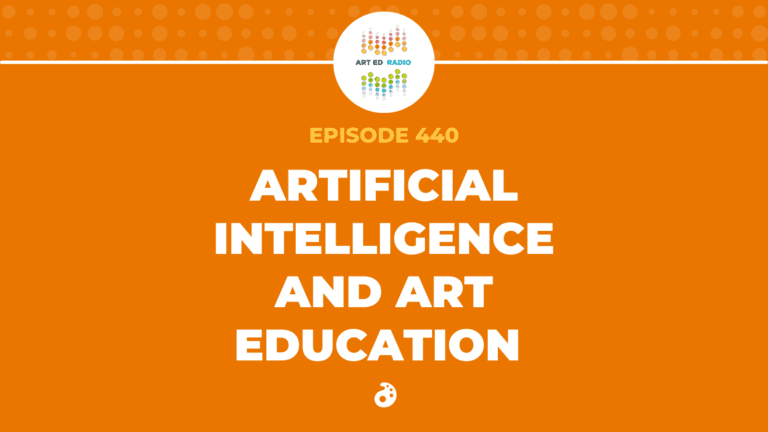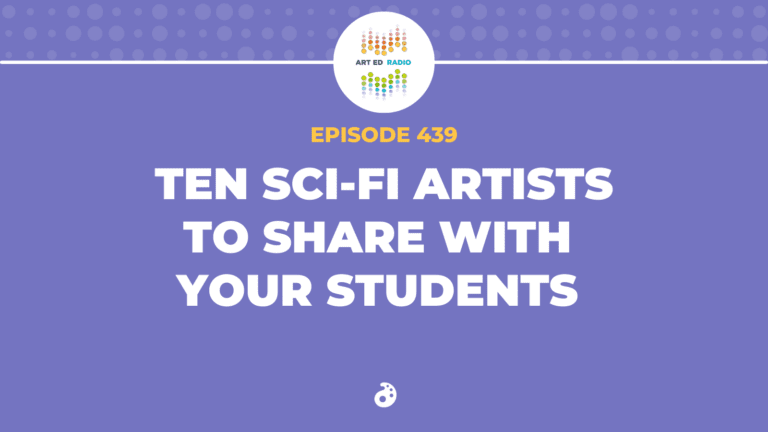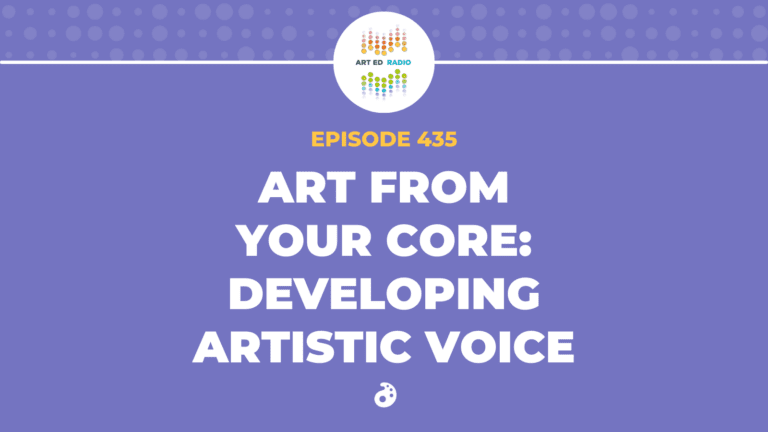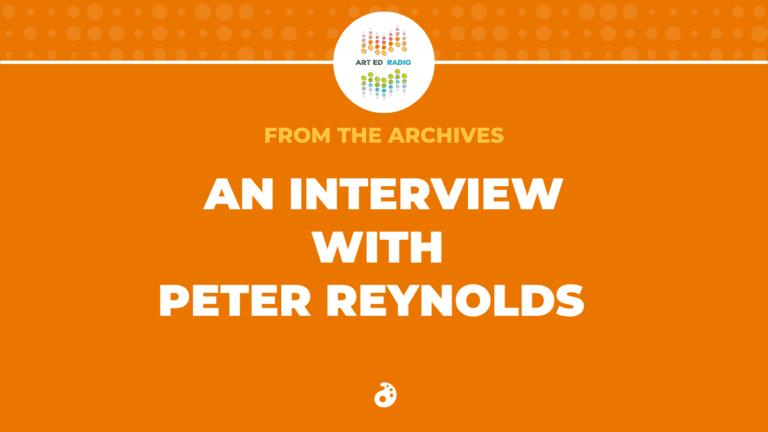In his second episode as guest host, Candido Crespo is joined by Keondra Prier—a museum educator at the Baltimore Museum of Art—to discuss the relationships between schools and museums. Listen as their conversation covers how we can provide learning opportunities through museums, how the pandemic has affected museum visits, and how teachers can strengthen their connections to the community at large. Full Episode Transcript Below.
Resources and Links
- How to Convince Your Administrator to Send Your Class on a Museum Field Trip
- Five Stress-Free Tips for Planning Art Museum Field Trips
- FLEX Collection: Exploring Digital Art Museums
- Apply to be an AOEU Podcast Host!
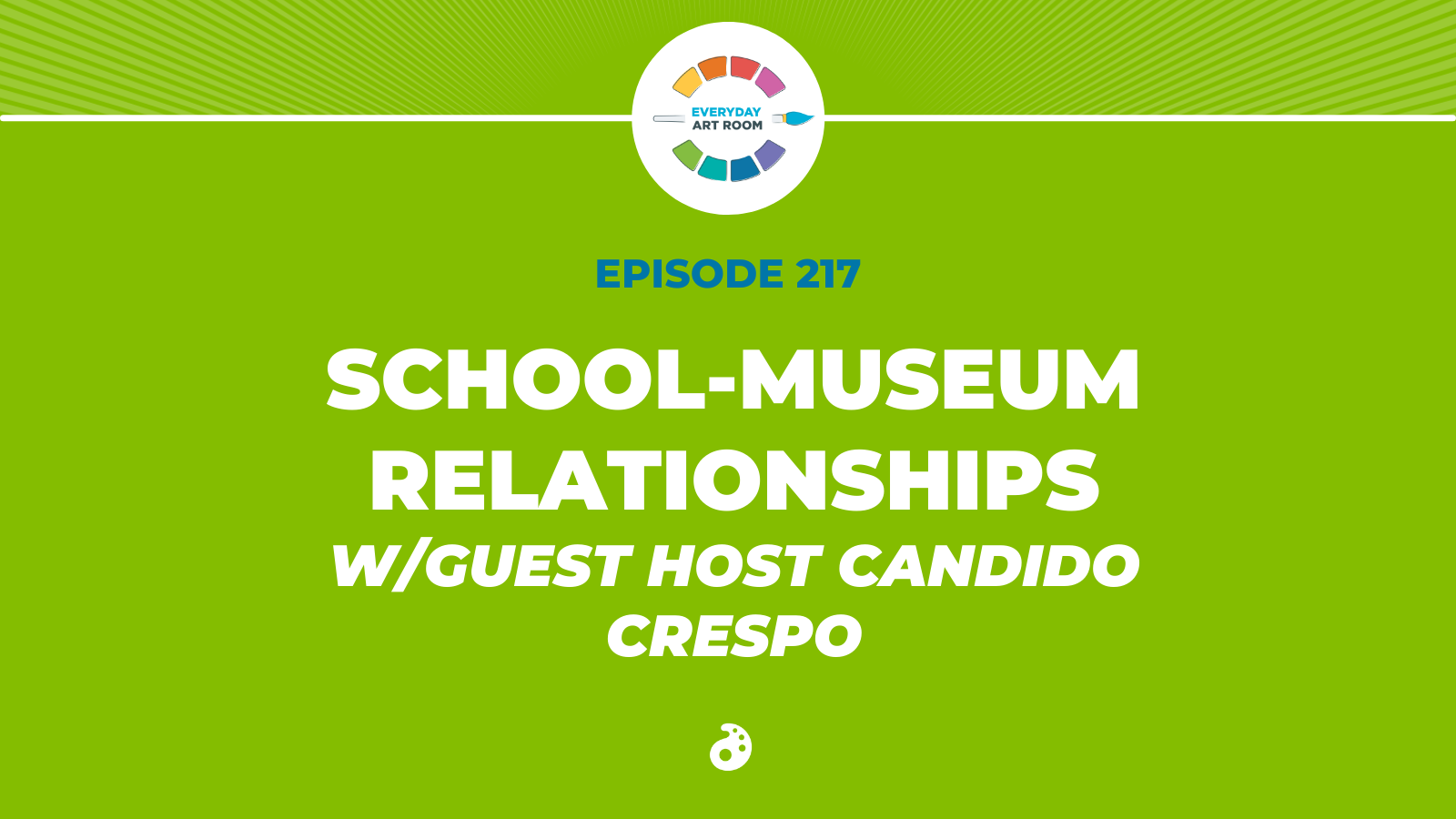
Transcript
Candido: I can’t be the only one who loved field trips as a student. I mean, I love them as an adult, giving students real-world experience strengthens and supports our in-class lessons. I think trips to an art museum do this especially well, but I’m wondering, are we capitalizing on all the opportunities that exist and are afforded to us as art teachers like specialized visits or children workshops, maybe professional development opportunities or ongoing partnerships that benefit the community?
And I wonder how the pandemic has also altered these experiences. I’ve called on my dear friend, Keondra Prier of the Baltimore Museum of Art. Her knowledge and insight will be of great value in this conversation. So let’s do this. This is Everyday Art Room, and I’m your host, Candido Crespo. Keondra, thank you for joining. Could you please introduce yourself and tell us a little bit more about you?
Keondra: Well, thank you for having me. My name is Keondra Prier. I am a museum educator. I’m currently working at the Baltimore Museum of Art and I previously worked at the Brooklyn Museum of Art and the Walters Art Museum as a museum educator, as someone who works with students in galleries, learning in front of art, and also in teaching professional development to teachers and how they can translate that type of work into their classroom.
Candido: Okay. So I’m super curious, both as a friend and a colleague. Now, why museum educator as opposed to the classroom?
Keondra: It’s a really great question. I always loved teaching. I just didn’t really know, I guess in my mind, I always imagine that eventually I’d end up in the classroom as a K-12 teacher, but I had so many different types of interests. I really wandered my way into becoming an educator, to be honest. So the way I got into museum education was through a volunteer job that turned into a permanent job, and an opportunity arose through a colleague that I had met while volunteering and while working and I applied and somehow got the job to become an educator at the Brooklyn Museum, which for folks that might not know, or might not be familiar with the education department at the Brooklyn Museum, it’s known as one of the foremost social justice-oriented education programs in the country that really takes it upon themselves to train some of the greatest museum educators in the country.
And so I just felt incredibly lucky, but I kind of learned, and my craft through the fire a little bit through a lot of embarrassing experiences because I started as an educator of teachers, which I always say is the hardest thing you can possibly do teaching teachers. They’re the toughest crowd. And they’ll tell you when you suck. And I was told many times that I was failing, but that’s how I learned how to become a better educator. Was learning the really specific ways to a question, to plan, to direct, and to be really extremely specific with word choices in the gallery. And so that’s how I became a museum educator honestly, was through an incredible opportunity and luck, but I feel like I stayed in the field through an incredible amount of studying trial and error and through the graciousness of teachers and administrators guiding me along the way.
Candido: Wow. Yeah. So I’ll apologize on behalf of us educators, but yes, we could be a very tough crowd. You could ask any of our administrators how our faculty meetings go. Brooklyn Museum is in New York, where is The Walter Art Museum?
Keondra: It’s in Baltimore, Maryland.
Candido: Okay. And this, most of the listeners who listen to the everyday art room are actually elementary school art teachers. So what has been your experience in working with elementary schools?
Keondra: So the vast majority of students that come for museum field trips are, I think, K-5 students, there tends to be a drop off in middle school and high school. So a lot of work is done in trying to develop programming for early, from early childhood to fifth grade. I would say even maybe third grade, in some instances like at the Walters Art Museum. So I would say the majority of my teaching at the Walters especially was geared towards elementary school students and supporting teachers in figuring out how to talk about issues of race, gender, and sexuality, actually at the elementary school level through contemporary works of art in the Brooklyn Museum collection. And then talk about those issues again, in a more historic collection at the Walters Art Museum. So that’s been my experience is trying to translate some really difficult topics that I think teachers more and more were interested in engaging in, or were especially now fearful of engaging with their students because of the political climate that we’re in, which wasn’t as prevalent when I started, but certainly is now.
But I think those strategies were things that they were really interested in tackling through the museum. And so that’s, I think where I spent most of my time in my workshops in PD. But outside of that, as a manager of educators and as an educator, I was also teaching tours, so when students would come in with their teachers, I would sometimes probably I guess the most I taught was probably two to three times a week in the gallery. So not as frequently as everyday educators, but so I split my time between teaching and the galleries on, in those shorter trips and then longer form workshops that would be either full day or multiple weekends.
Candido: Wow. Okay. So it’s no secret. We are in, continue to be part of a pandemic. I’m wondering, how has the pandemic affected the relationship between schools and museums or maybe your job at large?
Keondra: It was my, a monumental shift. I think it was a monumental shift for all teachers obviously, or maybe not. So obviously people really had to change the ways that they thought about their curriculum, how they would engage with students now through this digital barrier and digital divide. So it was a huge shift in the way that just on a curricular level, teaching happened in an art museum. But on top of that, I think it required museums specifically to rethink the ways they thought about engaging partners period, but specifically schools, because there was a very much an over-reliance and kind of comfort with the number of students that we expected to serve annually through the school visit programs. And I think in general, museums expect large amounts of funding to come through basically a headcount of how many students we serve annually.
So everything else was almost supplemental to that, if that makes sense. So even my workshops, if they would happen, it was really driven by the desire of museum educators and the education department itself to kind of expand and experiment and think through different things that teachers and administrators were saying they wanted, but the bulk of our energy would really go towards serving those one-time visitors. So suddenly, obviously, as people are really concerned about their health in a pandemic, people are way more learn about “how am I even going to go to work? How am I going to go to school? How am I going to keep my children safe?” They’re certainly not thinking, “oh, how will I get into a museum for a tour?” Right. So suddenly, truly overnight, we have to cancel every tour. And it, the way that we did it was even though in my head, I knew that this was going to be a very long-term issue.
We started canceling okay. Week by week. Oh, I don’t think like, starting right the third week of March, we’re like, “I don’t think next week we’re going to be giving tours.” And I think eventually were like, okay, no tours for the rest of the school year. And we would look at it like that. And, but from a museum educator standpoint, I think although there was a lot of nervousness around that because our funding is directly tied to the amount of student we serve because some of our funding comes directly through the state education departments and being able to fulfill certain obligations as to how many people and how many students specifically come through the doors. We also saw the other side of it, which was finally what we’ve been kind of shouting from the rooftops about that over alliance on one-time visits, really thinking and working with students and teachers and administrators to really think, what do you actually want to see?
I know going to a museum is really fun. Looking at these objects in person is great. And I know that those things are really important. So I wouldn’t want to take away from that. But the things that I think museum educators were interested in exploring with the students kind of were marginalized issues until the pandemic. Where we really had to truly think about, okay, what does it mean to engage a student digitally? What does it mean if no one wants to come through the door? What are the, what is the essence of museum education and how can we translate that in ways that we might have been a little bit lazy about because you can come see a sarcophagus or, oh my goodness, you want to see this incredible work of art, so you don’t really care what kind of methods we’re using, what the underlying pedagogy, the theory, none of that really mattered as much as the entertainment value of coming to the museum.
So suddenly we were able to articulate really clearly to administrators and senior leadership, what we were actually doing when they kind of saw us as just in a lot of ways. And I, I’m not, not trying to be negative about it, but I think in a lot of ways we were seen as babysitters or the women that would wipe the kids’ noses and make them happy. Instead of, as people that were really invested in theory and asking challenging questions and having serious conversations with students that have serious life experiences, that they were then empowered to describe and talk about in front of works of art. So I think it’s, I think the issues within education in K-12 education and how seriously as a society, we take young people and teachers and what they do in the classroom very much translated over into the realm of the museum and how seriously the field of museum education is taken.
So the pandemic for us presented a real reset and reaffirmed what those things that we were actually doing and building up importance outside of a headcount. So outside of, “oh, we brought in 3000 students,” it’s like, “oh, you’re doing serious real things” that people actually want and need. And we were for a time, the only thing that was happening in the museums, especially when museums began to close their doors, every interface, or for the most part in museums was with museum educators, whether or not people realized that is another thing, but suddenly the work of, preserving art of displaying art and didn’t really become visible to our visitors, but the work of the educators did. And so it was a very transformative time. I, and, but the bigger question is how long will that transformation last.
Candido: Right. Okay. So I’m listening to your answers. And of course I’m taking notes because there’s a lot to consider here. So something that, I know we’ve discussed is maybe the misunderstanding of the value of museum educators to teachers. I don’t think it would be common sense because I guess, if we enrolled in or if I made a comparison, it would be to an, in building situation would be like the librarian and the classroom teacher, right. The librarian still needs to do just as much education still has to go through as much certification, but sometimes they end up in the same scenario where they too are babysitting as opposed to providing essential knowledge, like how to find a book, like how, what are good books? Like what are the books that we’re looking for? Understanding, just different elements of literacy that classroom teachers are not privy to because it’s not, they didn’t undergo the same level of education. So I, this is another, I’m speaking on behalf of teachers and saying that while it may not be common sense, you are appreciated.
And then I have another question because I saw it happening on social media. There was definitely a spike in museum participation on Instagram and YouTube. You, I’ve seen you conduct interviews with artists over YouTube. Was there a significant spike in educational institutions reaching out to museums for like presentations, professional development and information of greater diversity, like looking for more multicultural lessons? I’ve spoken to museum educators in the past and said that this has happened before, where museums became a critical source of information. Did that same thing happen as a result of this past movement?
Keondra: That’s a great question. I think that’s a hard one for me to answer because all of my work has always been centered around those issues. Like that’s what drove me into working in museums. I do think there was an uptick in support from within. So I think, and I don’t want to speak, paint the brush too broadly because I think museums are extremely diverse and how they talk about issues, their interest in discussing those types of topics. And so yeah definitely. There’s a, I think there’s an increase of just publicity around people doing that work already. That’s how I would frame it. So like if you’re a black artist and you’ve been a black artist, you’re a Latino artist, you’ve been a Latino artist the whole time. All of a sudden they’re like, “oh! You exist.” You know, like I think that that moment definitely happened.
And I think that the work for me personally, that I was kind of agitating for a long time was suddenly relevant because I think it was harder to say no during the protest during, post-George Floyd to me saying, “Hey, can we talk about the one black artist of this time period in our collection?” It’s harder to say no to that. Whereas before it’s like, oh, well, can we talk about these other things first, even in a city like Baltimore, that is I think 60% black. It was still a hard argument to be made for featuring more relevant and race is not the only relevant issue in Baltimore. But one of many relevant issues that connect to people living in the city. I think that as educators, as museum educators, I’ll say like, I think what makes museum education departments in museums a little bit different is that we tend, I’ll say 10.
We tend towards trying focus on people. Whereas much of the museum is very focused on art got and how to make art relevant to people instead of trying to focus on what people find interesting and elevating those topics for people. So I think, and that comes out of education departments being formed historically formed by the same folks that formed the public education system. So the drive is a little bit different because we’re coming, the same folks in the 19 hundreds that were kind of theorizing around the value of public education and the public school systems were the same folks that were saying, “Hey, museums, you need to have education departments doing similar work yeah. To educate the public.” So I think that’s why there’s more alignment with public school systems and museum education departments. But sometimes that alignment isn’t the same throughout the rest of the museum.
So to go back to your question, if I thought that there was more of an ask for me to do things absolutely. But I think it was more so a recognition of who else in the building can do this. And I think museum educators are particularly good at asking questions and having conversations and thinking on the fly and being able to engage and talk to people in a way that other people in a museum setting are geared towards really focusing on objects, talking to people that are already interested in the things that they’re kind of pontificating rather than in engaging folks that might not be interested in the thing that might be on the whiteboard that day.
Candido: Okay. All right. So here’s my next question. We’ve talked about the things that, or the current status of relationships between educational institutions outside of the museum and the museum. How do you envision strengthening the relationship between the two institutions?
Keondra: I think this is definitely a holdover from what I learned over the pandemic, which is to listen, which seems really silly, but I think museums as institutions tend to feel like they know what they need to know, and then what their problem is, is sharing what they know and people understanding what they already know. But I would say that, that’s actually not the issue. I think the issue for museums is believing that people know things and that they are knowledgeable and they have their own experiences and that museums themselves can learn from the people. So I think that what I think will help with strengthening that partnership moving forward is what seems to be common sense, which is to literally, if you’re serving K through 12 audiences to ask them, what do you need? What are you dealing with right now? How can I make that easier for you?
What are the, “Hey, here’s what I was thinking, in response to what you told me, does this sound like a good idea?” And then having that back and forth relationship that’s open enough that people can say that’s real dumb. That doesn’t work for me. That doesn’t fit my structure. And over the pandemic, I was lucky enough that people gave me that time because, educate teachers K through 12 educators were, I don’t need to explain that to you, what you all were going through. But I was extremely lucky to have a good amount of administrators and educators be willing to talk to me and tell me, “Hey, the way that you’re thinking about this makes absolutely no sense for our structure. It doesn’t work, it can’t work, but this is how it can” and giving me the time and the grace to figure out ways to make our model work for you all.
And then also to reinvent our model so that it makes, it’s more in alignment with the K-12 structure, which was very much in flux the last two years. It changed day to day, month to month, how you all were navigating the classroom. And that meant that the museum couldn’t just say, “Hey, this is the time slot, click in.” You had to change to, you had to mold yourself to the new ever-changing classroom. So I hope if anything, that’s a holdover is that we stop making decisions independently and thinking that classrooms will just bend into the mold that we set. And instead that we do that more collaboratively on the schedule, on the school schedule and the way that you all think about things. If you’re planning beginning at the end of spring, we should be beginning to plan about our school year in the beginning of spring or earlier, so that we can integrate ourselves into the system as it exists, instead of making up a random calendar and hoping it works.
Candido: All right. So this conversation is getting me super excited because I am looking forward to also building these relationships more locally of course. Unless I get the, I guess I take the bus out to Baltimore, but I don’t know. I don’t know if in Long Island, the education system would want me to do that, but something that we can capitalize on. And I know because some of these things are happening virtually is what should educators know about opportunities for professional development at museums?
Keondra: I think the most important thing to know is that they exist, that there you have allies within probably every museum in America that wants to serve you, and that you are extremely powerful in getting that professional development and advocating for that professional development where you are. And that there is an incredible amount of funding that it’s, that the department of education gives to these museums to serve you.
And so that makes you a very special and important constituent for the museum system in ways that many people don’t know. So what I would say is really important is to, if you’re interested in taking workshops, or if you see some more that museums are doing that you’re interested in reach out to your district administrator or to your principal, let them know that, that’s something that you’re interested in. And I can almost guarantee that there is a museum educator out there willing to craft a professional development program for your school for your district. But also there’s like individualized workshops that you can take that usually the school system supplement and pay for. So it would be very low to no cost for you. And at least at the Brooklyn Museum, I know for sure those things were also for PD credit or whatever the credit system is for you. And sometimes there are state-level credits as well that museums will get. So there’s a lot of incentives to take professional development at museums and they do go through the same accreditation processes as other professional development workshops.
Candido: Oh, that’s excellent. I have one last question. When we think about the stakeholder that are involved in education, of course, we think about the students, the teachers, the parents, the administration, but the community at large is definitely part of the stakeholders involved in education. Your title or responsibilities have expanded recently to include community engagement. Could you tell us a little bit about how that’s looking?
Keondra: Sure. And any, you are, will see that across the country, if not the world really right now realizing the importance of community involvement and decision making in museums. So, but that requires a really deep change in the infrastructure of museums themselves, who are not used to engaging with the community. So right now I am working with some members of staff at the Baltimore Museum of Art to rethink some of their structures and the way in which they’re engaging with the community to really give some transparency to the way museums work and how important the community is in the future of what museums ought to be.
So my work working with teachers and during the pandemic and over this past year and developing curriculum in partnership with teachers and administrators has taught me a lot in what that looks like. And I hope to translate that work into the work that I’m doing now in engaging in partnership and honest partnership, where you truly believe in the knowledge that people bring to the table, which is multifaceted and implementing that into the way that these structures will work moving into the future.
Candido: Wow. Okay. Well, here’s where I say thank you so much for your knowledge and time. So here’s what I learned or I guess what’s been reinforced. Museums are so cool! There are so many opportunities waiting for us. They care about our students just as much as we do and want to help raise our little artists to new heights.
I want to thank Keondra Prier for taking the time to share her knowledge and experience with us. And if you are in Baltimore, Maryland area, be sure to drop in and reach out to her at the Baltimore Museum of Art, if you’re looking for additional resources, start at the AOEU website, there you can find articles like How to Convince Your Administrator to Send Your Class on a Museum Field Trip by Sarah Hale Keuseman and Five Stress-Free Tips for Planning Art Museum Field Trips by Jordan DeWilde. In the FLEX curriculum, you’ll find exploring digital art museums. That’s the one that my district would probably push me towards right now. Thanks for listening to Everyday Art Room. I hope you’ve learned enough to want to learn more. Catch you next week.
Magazine articles and podcasts are opinions of professional education contributors and do not necessarily represent the position of the Art of Education University (AOEU) or its academic offerings. Contributors use terms in the way they are most often talked about in the scope of their educational experiences.
